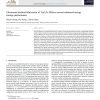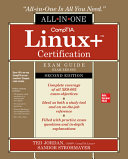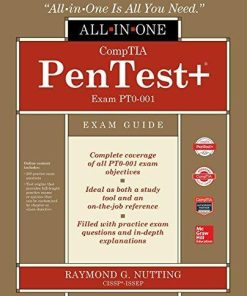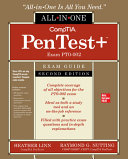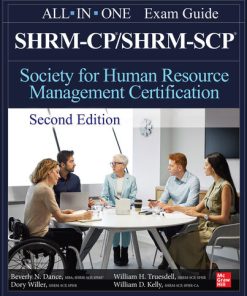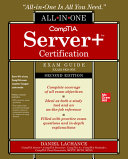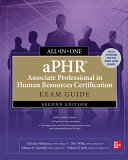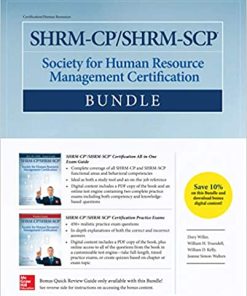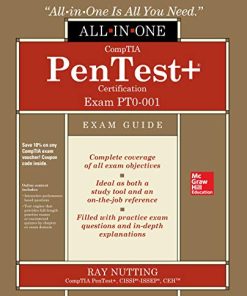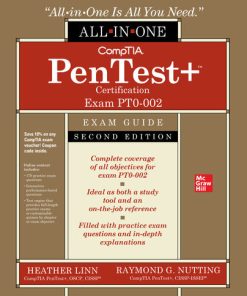(Ebook PDF) SHRM CPSHRM SCP Certification All In One Exam Guide 2nd Edition by Beverly Dance 1265022860 9781265022860 full chapters
$50.00 Original price was: $50.00.$25.00Current price is: $25.00.
SHRM-CP/SHRM-SCP Certification All-In-One Exam Guide 2nd Edition by Beverly Dance – Ebook PDF Instant Download/DeliveryISBN: 1265022860, 9781265022860
Full download SHRM-CP/SHRM-SCP Certification All-In-One Exam Guide 2nd Edition after payment.
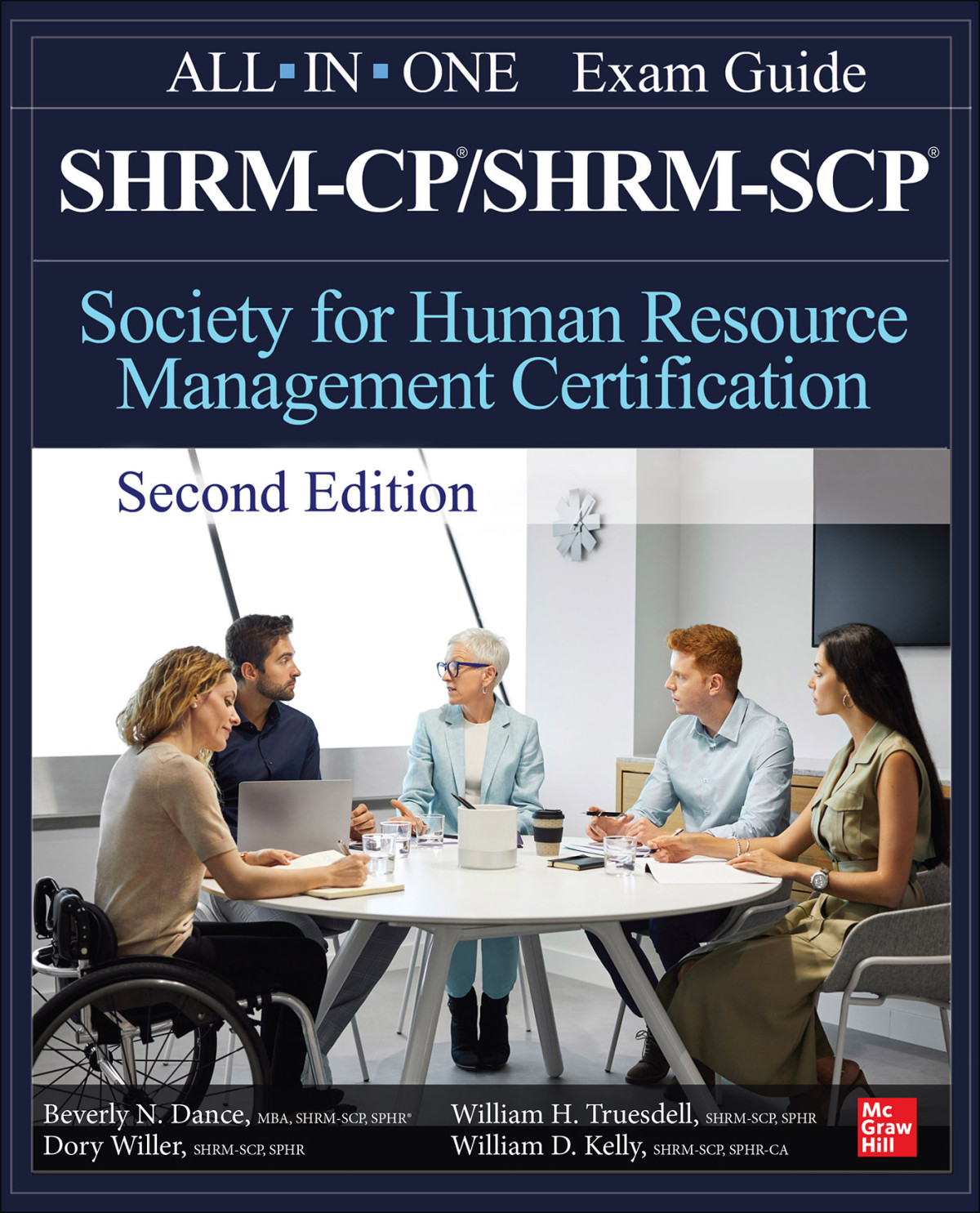
Product details:
ISBN-10 : 1265022860
ISBN-13 : 9781265022860
Author: Beverly Dance
Take the SHRM-Certified Professional (SHRM-CP) and SHRM-Senior Certified Professional (SHRM-SCP) exams with confidence Get complete coverage of every topic included on the Society for Human Resource Management certification exams―the SHRM Certified Professional (SHRM-CP) and the SHRM Senior Certified Professional (SHRM-SCP). Written by a team of HR experts, the book provides learning objectives at the beginning of each chapter, hands-on exercises, exam tips, and practice exam questions with in-depth answer explanations. Designed to help you pass the exam, this definitive volume also serves as an essential on-the-job reference. Offers complete coverage of the 2023 SHRM Body of Skills and Knowledge (BASK), including all of the following behavioral competency clusters and HR expertise domains for both exams: Leadership Interpersonal Business People Knowledge Organization Knowledge Workplace Knowledge Online content includes: Two complete practice exams including both competency and knowledge-based questions Customizable knowledge-based quiz—test yourself by exam topic or chapter Drill down on the scenario-based questions with a focused situational judgment item quiz
SHRM-CP/SHRM-SCP Certification All-In-One Exam Guide 2nd Table of contents:
Part 1 The Human Resource Profession
Chapter 1 Human Resource Certification
Professional Human Resource Management Certification
Benefits of Certification
HR Certification Organizations
The HR Certification Institute
The Society for Human Resource Management
Chapter Review
References
Chapter 2 SHRM’s Certification Program
HR Expertise/Knowledge
SHRM’s BoCK Advisory Panel
SHRM Certification Commission
The SHRM Body of Applied Skills and Knowledge
SHRM-CP and SHRM-SCP Exam Eligibility
Which Certification Is Right for You?
Application Deadlines and Exam Windows
Exam Delivery, Duration, and Format
Exam Content Outline
Exam Identification and Conduct Guidelines
More on the Test Center
How Exams Are Scored
Chapter Review
References
Chapter 3 U.S. Laws and Regulations
What You Need to Know Concerning Employee Management
1. When You Have One or More Employees
1.1. The Clayton Act (1914)
1.2. The Consumer Credit Protection Act (1968)
1.3. The Copeland “Anti-Kickback” Act (1934)
1.4. The Copyright Act (1976)
1.5. The Davis-Bacon Act (1931)
1.6. The Dodd-Frank Wall Street Reform and Consumer Protection Act (2010)
1.7. The Economic Growth and Tax Relief Reconciliation Act (EGTRRA) (2001)
1.8. The Electronic Communications Privacy Act (ECPA) (1986)
1.9. The Employee Polygraph Protection Act (1988)
1.10. The Employee Retirement Income Security Act (ERISA) (1974)
1.11. The Equal Pay Act (EPA) (Amendment to the FLSA) (1963)
1.12. The FAA Modernization and Reform Act (2012)
1.13. The Fair and Accurate Credit Transactions Act (FACT) (Amendment to the FCRA) (2003)
1.14. The Fair Credit Reporting Act (FCRA) (1970)
1.15. The Fair Labor Standards Act (FLSA) (1938) and Provisions Effective January 1, 2020
1.16. The Foreign Corrupt Practices Act (FCPA) (1997)
1.17. The Health Information Technology for Economic and Clinical Health Act (HITECH) (2009)
1.18. The Health Insurance Portability and Accountability Act (HIPAA) (1996)
1.19. The Immigration and Nationality Act (INA) (1952)
1.20. The Immigration Reform and Control Act (IRCA) (1986)
1.21. The IRS Intermediate Sanctions (2002)
1.22. The Labor-Management Relations Act (LMRA) (1947)
1.23. The Labor-Management Reporting and Disclosure Act (LMRDA) (1959)
1.24. The Mine Safety and Health Act (MSHA) (1977)
1.25. The National Industrial Recovery Act (1933)
1.26. The National Labor Relations Act (NLRA) (1935)
1.27. The Needlestick Safety and Prevention Act (2000)
1.28. The Norris-LaGuardia Act (1932)
1.29. The Occupational Safety and Health Act (OSHA) (1970)
1.30. The Omnibus Budget Reconciliation Act (OBRA) (1993)
1.31. The Pension Protection Act (PPA) (2006)
1.32. The Personal Responsibility and Work Opportunity Reconciliation Act (1996)
1.33. The Portal-to-Portal Act (1947)
1.34. The Railway Labor Act (1926)
1.35. The Rehabilitation Act (1973)
1.36. The Retirement Equity Act (REA) (1984)
1.37. The Revenue Act (1978)
1.38. The Sarbanes-Oxley Act (SOX) (2002)
1.39. The Securities and Exchange Act (1934)
1.40. The Service Contract Act (SCA) (1965)
1.41. The Sherman Anti-Trust Act (1890)
1.42. The Small Business Job Protection Act (SBJPA) (1996)
1.43. The Social Security Act (1935)
1.44. The Tax Reform Act (1986)
1.45. The Taxpayer Relief Act (1997)
1.46. The Trademark Act (1946)
1.47. The Unemployment Compensation Amendments Act (UCA) (1992)
1.48. The Uniformed Services Employment and Reemployment Rights Act (USERRA) (1994)
1.49. The Vietnam Era Veterans Readjustment Assistance Act (VEVRAA) (1974) [As Amended by the Jobs for Veterans Act (JVA) (2008)]1.50. The Wagner-Peyser Act (1933), As Amended by the Workforce Investment Act (WIA) (1998) and the Workforce Innovation and Opportunity Act (WIOA) of 2014
1.51. The Walsh-Healey Act (Public Contracts Act) (1936)
1.52. The Work Opportunity Tax Credit (WOTC) (1996)
1.53. Labor-Management Reporting and Disclosure Act (LMRDA) (1959)
1.54. Whistleblowing
2. When You Have 15 or More Employees
2.1. Americans with Disabilities Act (ADA) (1990)
2.2. Civil Rights Act (Title VII) (1964)
2.3. The Civil Rights Act (1991)
2.4. Drug-Free Workplace Act (1988)
2.5. The Equal Employment Opportunity Act (EEOA) (1972)
2.6. The Genetic Information Nondiscrimination Act (GINA) (2008)
2.7. Guidelines on Discrimination Because of Sex (1980)
2.8. The Lilly Ledbetter Fair Pay Act (2009)
2.9. The Pregnancy Discrimination Act (PDA) (1978)
2.10. Uniform Guidelines on Employee Selection Procedures (1976)
3. When You Have 20 or More Employees
3.1. The Age Discrimination in Employment Act (ADEA) (1967)
3.2. The American Recovery and Reinvestment Act (ARRA) (2009)
3.3. The Consolidated Omnibus Budget Reconciliation Act (COBRA) (1986)
3.4. The Older Workers Benefit Protection Act (OWBPA) (1990)
4. When You Have 50 to 99 Employees
4.1. Executive Order 11246—Affirmative Action (1965)
4.2. The Family and Medical Leave Act (FMLA) (1993) and Amendments from the National Defense Authorization Act of 2010
4.3. The Mental Health Parity Act (MHPA) (1996)
4.4. The Mental Health Parity and Addiction Equity Act (MHPAEA) (2008)
4.5. The National Defense Authorization Act (2008)
4.6. The Patient Protection and Affordable Care Act (PPACA) (2010)
5. When You Have 100 or More Employees
5.1. The Worker Adjustment and Retraining Notification Act (WARN) (1988)
6. For Federal Government Employees
6.1. The Civil Service Reform Act (1978)
6.2. The Congressional Accountability Act (1995)
6.3. The False Claims Act (1863)
6.4. The Homeland Security Act (2002)
6.5. The Privacy Act (1974)
6.6. The USA PATRIOT Act (2001)
Employment Visas for Foreign Nationals
E Nonimmigrant Visas
H Visas
L-1 Intra-Company Transferee
O-1 Alien of Extraordinary Ability in Arts, Science, Education, Business, Athletics
P Visa Categories
EB Employment-Based Visas
Chapter Review
Questions
Answers
References
Part II HR Knowledge and Behavior Competencies
Chapter 4 People
Functional Area 1: HR Strategy
Key Concepts
The Role of Strategy
Strategy Formulation
Developing Strategy
Implementing Strategy Production
Evaluating Strategic Performance
Providing Leadership and Strategy
Functional Area 2: Talent Acquisition
Key Concepts
Organizational Staffing Requirements
Strategic Staffing
Planning for Talent Acquisition on a Global Basis
Employment Branding
Job Analysis and Job Documentation
Sourcing and Recruiting
Selection
Orientation and Onboarding
Functional Area 3: Employee Engagement & Retention
Key Concepts
Understanding Employee Engagement
Drivers and Role of Organizational Culture in Engagement
Challenges to Employee Engagement
HR’s Employee Engagement Strategy
Assessing Employee Engagement
Engaging Employees—From Hiring to Separation
Performance Management
Retention
Functional Area 4: Learning & Development
Key Concepts
Learning and Development in Today’s Organizations
Adult Learning
Training and Development
Career Development
Developing Leaders
Functional Area 5: Total Rewards
Key Concepts
Total Rewards and Organizational Strategy
Compensation Structure
Compensation Systems
Benefits and Perquisites
Legislation Affecting Compensation and Benefits
Chapter Review
Questions
Answers
References
Chapter 5 Organization
Functional Area 6: Structure of the HR Function
Key Concepts
The Strategic Role of HR
Understanding the Organization
The HR Organization and Function
Measuring and Demonstrating HR Value
HR’s Role in Organizational Strategy
Functional Area 7: Organizational Effectiveness & Development
Key Concepts
Overview of Organizational Effectiveness and Development (OED)
Organizational Gap Development
Implementing OED Initiatives
Measuring Organizational Effectiveness and Development
Functional Area 8: Workforce Management
Key Concepts
Organizational Workforce Requirements
Workforce Planning
The Staffing Plan
Employee Development
Succession Planning
Knowledge Management
Functional Area 9: Employee & Labor Relations
Key Concepts
The Employment Relationship
Third-Party Influences on Employee Relations
When the Employee Relationship Falters
Functional Area 10: Technology Management
Key Concepts
HR and Technology
HR in the Era of Big Data
HR Information Systems
Policies for Technology Use in the Workplace
Chapter Review
Questions
Answers
References
Chapter 6 Workplace
Functional Area 11: Managing a Global Workforce
Key Concepts
The Global Context
Defining the Global Organization
Creating a Global Strategy
Becoming a Multicultural Organization
Managing Global Assignments
Navigating the Global Legal Environment
Functional Area 12: Risk Management
Key Concepts
Establishing the Context of Risk
Identifying and Analyzing Risk
Managing Risks
Evaluating Risk Management
Functional Area 13: Corporate Social Responsibility
Key Concepts
The Ever-Changing and Growing CSR
Creating a CSR Strategy
Philanthropy and Volunteerism
Functional Area 14: U.S. Employment Laws & Regulations
Key Concepts
Organizational Compliance
U.S. Laws and Regulations
Employee Records Management
Chapter Review
Questions
Answers
References
Chapter 7 Behavioral Competencies
Leadership Cluster
Behavioral Competency 1: Leadership and Navigation
Key Concepts
Definition
Proficiency Indicators for All HR Professionals
Proficiency Indicators for Senior HR Professionals
Summary
Behavioral Competency 2: Ethical Practice
Key Concepts
Definition
Proficiency Indicators for All HR Professionals
Proficiency Indicators for Senior HR Professionals
Summary
Behavioral Competency 3: Diversity, Equity & Inclusion (DE&I)
Key Concepts
Definition
Proficiency Indicators for All HR Professionals
Overview: Key Terms
Visible and Invisible Traits
Proficiency Indicators for Senior HR Professionals
Developing a Diversity, Equity, and Inclusion Strategy
Summary
Interpersonal Cluster
Behavioral Competency 4: Relationship Management
Key Concepts
Definition
Basic Proficiency Indicators
Proficiency Indicators for Senior HR Professionals
Summary
Behavioral Competency 5: Communication
Key Concepts
Definition
Proficiency Indicators for All HR Professionals
Proficiency Indicators for Senior HR Professionals
Summary
Behavioral Competency 6: Global Mindset
Key Concepts
Definition
Proficiency Indicators for All HR Professionals
Proficiency Indicators for Senior HR Professionals
Summary
Business Cluster
Behavioral Competency 7: Business Acumen
Key Concepts
Definition
Proficiency Indicators for All HR Professionals
Proficiency Indicators for Senior HR Professionals
Summary
Behavioral Competency 8: Consultation
Key Concepts
Definition
Proficiency Indicators for All HR Professionals
Proficiency Indicators for Senior HR Professionals
Summary
Behavioral Competency 9: Analytical Aptitude
Key Concepts
Definition
Proficiency Indicators for All HR Professionals
Proficiency Indicators for Senior HR Professionals
Summary
Chapter Review
Questions
Situational Judgment Scenario-Based Questions
Answers
People also search for SHRM-CP/SHRM-SCP Certification All-In-One Exam Guide 2nd:
what is shrm-cp or shrm-scp certification
how many questions are on the shrm cp exam
what is shrm-cp or shrm-scp
is the shrm cp exam hard
shrm-cp certification cost
Tags:
SHRM CPSHRM SCP,Certification,All In One,Exam Guide
You may also like…
Computers - Computer Certification & Training
CompTIA Linux+ Certification All-in-One Exam Guide (Exam XK0-005) 2nd Edition
Computers & Technology
CompTIA PenTest+ Certification All-in-One Exam Guide (Exam PT0-001) 1st Edition
Computers - Security
Business & Economics
Shrm-Cp/Shrm-Scp Certification All-In-One Exam Guide Second Edition Beverly Dance
Business & Economics - Human Resources
Computers - Computer Certification & Training
CompTIA PenTest+ Certification All-in-One Exam Guide (Exam PT0-002) 2nd Edition


